|
God of the Canaries and Intermarriage
The population of the Canary Islands goes to church on Sunday. Not, however, like we do in our villages, but in a truly individual and curious manner. Formally dressed men take their formally dressed wives to church like we do. At the door of the church, however, comes the salient change. While the women bid their husbands goodbye and enter the Sunday Mass, the men enter, with equal formality, the local bars and talk amongst themselves, and maybe even with God, over full glasses. After mass the satisfied husbands escort their satisfied wives home. Everything takes place swimmingly and perfect harmony predominates. It is no wonder then that the Sunday mass is eagerly awaited by everyone in every village.
Up until some 30 years ago the island of La Palma was so totally isolated from surrounding civilization, that in such a small society, intermarriage had to take place within families. Up to today for example, marriage between brother and sister is legally permissible, though not that common of an occcurrence. Cousins do however marry on the island commonly, still today. By the phone book it is possible to see that the populations of some villages consist of only a few families.
The results of these practices throughout generations are twofold. On the one hand there are more mentally handicapped children born on the island than the normal average elsewhere, which we observed on the streets. On the other hand, for every 100 girls born, there are only 70 boys born. This second fact is certainly not to be overlooked by Czech pilots, especially if he also takes into consideration that of those 100 babies most grow into truly beautiful girls.

Caldera de Taburiente
At an altitude of about 2,400 meters above sea level, near the highest mountain, Roque de los Muchachos, we found a very nice runway, as well a comfortable access route. This area is however a national park, Parque Nacional de la Caldera de Taburiente, in which flying is strictly forbidden. So not only was this runway not measured out but it hasn't even been included in the Flying landscapes section, although flying down from this place to the 13km distant port of Puerto de Tezacorte must be, in light of the beautiful surrounding terrain, an unrepeatable experience.
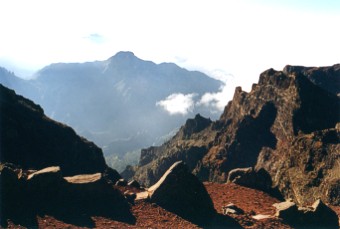
The Canary Islands are renown for their cleanliness of air and for this reason, astronomical observatories were built above 2000 meters on the Islands of Tenerife and La Palma, with immense telescopes.
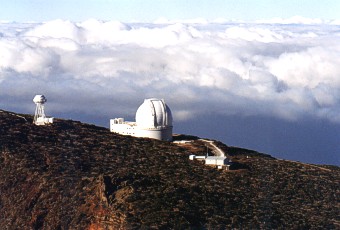
The peak of the highest mountain on La Palma, similar to Pico del Teide on the island of Tenerife, is often above the cloud cover and the panorama to the southeast and southwest early in the morning is truly fascinating. In crystal clear air you can even see the 140 mile distant peak of Pico del Teide on the island of Tenerife, as if in the palm of you hand. It's necessary not to oversleep however, because already around 10 o'clock in the morning , moisture in the air above the warmed cliff walls begins to condense rapidly and a layer of cloud is formed everywhere beneath the peak.
|
The thick pine forests at altitudes from 800 to 1600 meters, together with the impassable and damp primeval forest on its upper regions along with the frequent rainfall in the area, create a reservoir of fresh water for the entire island.
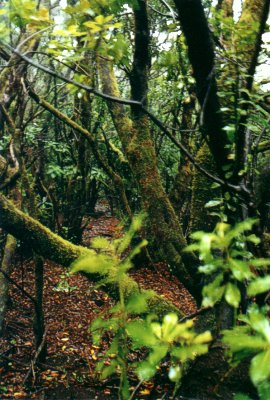
La Palma then, in contrast to the other islands of the Canaries, does not suffer from a lack of water and this is made apparent by the abundance of the local vegetation. Mountain trails, climbing the crests at heights of 1000 to 2000 meters above the sea, cut through beautiful terrain, as if created solely for mountain hiking, with grand panoramas of vistas of the shore of the island and the neverending blue of the Atlantic Ocean stretching to the horizon.
On the very good and relatively little frequented roads one can often see mountain bikes and even on the highest mountain of the island it is possible to ride up really comfortably. Of course to peddle 2426 meters on a bicycle cannot be considered a pleasant trip by everyone.
Bengal Night on the Square
Exactly one minute after midnight, that is already 1.1.2000, the first fireworks exploded above the shore, hundreds of rockets flew out over the Atlantic and on the clear sky covered with stars, geisers of colorful fireworks lit up the night. The inhabitants of the island of La Palma began celebrating the coming of the year 2000.
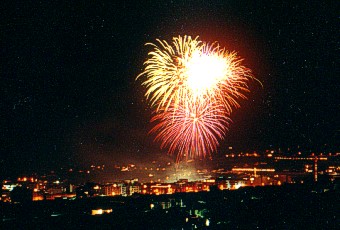
The expansive city square of Los Llanos de Aridane, including the side streets filled with a crowd of thousands in formal clothing. Not one man was without a white shirt and tie and all the women pulled the absolute best out of their wardrobes, as is the custom for such celebrations on the island. Long dresses with high slits and low neck lines, often barebacks, in short, the way we dress for the theater. In contrast to reserved Czechs, walking dignified in the halls of the theater, discussing things they don't understand during the intermission, the inhabitants of the island of La Palma don't connect their formal dress with formal behavior at all. The suit obviously doesn't make the man on the Canary Islands.
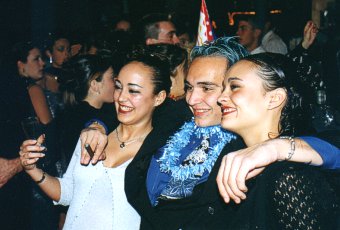
Mutual joyous hugging, kissing, well-wishing for the year 2000 went on for no end. A band on a raised platform belted out unbelievably wild Spanish music, and the whole happy crowd began to writhe wildly along with the rapid Spanish rhythms, and the mood of the unstoppable crown flowed out on all sides like lava from an errupting volcano.
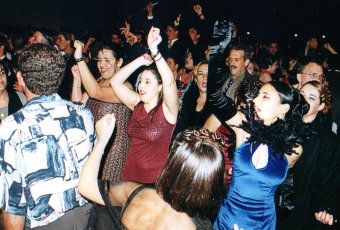
|






